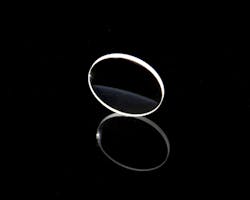Femto-line laser systems are developing rapidly in recent years, subsequently, one of its most crucial components, the demand for Ultra-thin (typically 0.1mm, 0.2mm) windows or substrates with high surface flatness (Lambda/10 or Lambda/4 @633nm) are surging.
The classical single surface polishing method, though utilized conventionally and commonly in the production of high precision laser grade optics products, practical implementation has proved its difficulty and unreliability while processing high flatness optics with miniature thickness. The reason is that, during the actual operation of classical single surface polishing, the polished optics are often put on pitch plate to accomplish the polishing procedure, the pitch plate and the optic are often bonded, inducing stress to the optics. You might manage to attain high surface quality(surface flatness and surface scratch/dig) while the optic is on the pitch plate, but once the optic is detached, the stress that comes from bonding is naturally released, leading to a slight change in the form of the optics, and the surface flatness will be eventually lowered. The thinner the optics, the more severe the impact of stress-releasing, since even the mildest deviation of the surface flatness could be significant as a proportion of the total thickness. To achieve high surface flatness in ultra-thin windows is always challenging for manufacturers.
To deal with the problem, Hangzhou Shalom EO has successfully developed a double surface polishing method for processing high precision optical windows or substrates, where both of the two surfaces of optics complete their polishing procedure in one go. The optics are not put on pitch plates during the procedure, so there is no stress releasing problem, which effectively eliminates the variation of surface flatness after it is taken off the pitch plates. The double surface polishing method is not incorporated in precise optics fabrication previously because the finished optics produced by this method have the defect of low surface quality (that is, relatively higher S/D). Hangzhou Shalom EO has done overcame this obstacle by improving the polishing machine, successfully raising the surface quality to 10/5 S/D, while exploiting the benefits of the double surface polishing method of precise surface flatness. Furthermore, excellent parallelism(10 arc sec) is also realized on the UVFS Ultra-thin Windows or Substrates.
